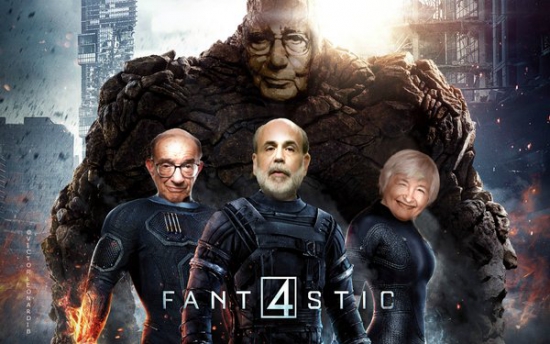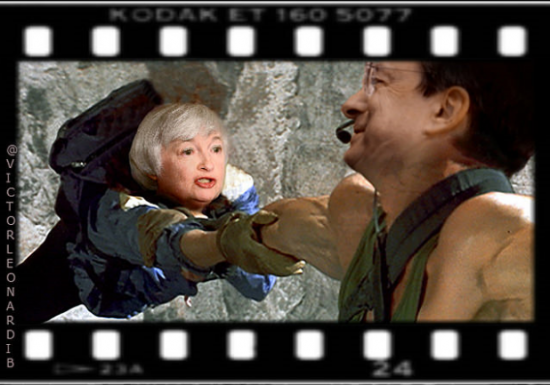SMART-LAB
Новый дизайн
Мы делаем деньги на бирже
Блог им. Kitten |Кто это сделал? Обзор на предстоящую неделю от 22.05.2016
- 22 мая 2016, 21:39
- |
По ФА…
На уходящей неделе:

Протокол ФРС
ФРС играет с рынками «в дурака».
Эта традиционная русская игра в интерпретации ФРС имеет несколько раундов.
В первом раунде ФРС подает рынкам сигнал о предстоящем повышении ставок, а рынки, состоящие из одних пузырей благодаря политике ФРС, падают в панике от перспективы лишения дешевых денег, подпитывающих эти пузыри.
Во втором раунде на сцену выходит Йеллен и голосом консьержа из «Нашей Раши» спрашивает: «Кто это сделал?».
Естественно, сам ФРС не может быть виноват, поэтому мальчиком для битья выступает наиболее актуальная на текущий момент проблема.
В прошлом году это была Греция, потом Китай, сейчас референдум в Британии, далее неиссякаемым источником глобальных рисков, злобно угнетающих экономику США, станет Еврозона, которая сама по себе представляет геморрой мира и проблемы в 2017 году там обещают размножаться быстрее кроликов.
( Читать дальше )
На уходящей неделе:

Протокол ФРС
ФРС играет с рынками «в дурака».
Эта традиционная русская игра в интерпретации ФРС имеет несколько раундов.
В первом раунде ФРС подает рынкам сигнал о предстоящем повышении ставок, а рынки, состоящие из одних пузырей благодаря политике ФРС, падают в панике от перспективы лишения дешевых денег, подпитывающих эти пузыри.
Во втором раунде на сцену выходит Йеллен и голосом консьержа из «Нашей Раши» спрашивает: «Кто это сделал?».
Естественно, сам ФРС не может быть виноват, поэтому мальчиком для битья выступает наиболее актуальная на текущий момент проблема.
В прошлом году это была Греция, потом Китай, сейчас референдум в Британии, далее неиссякаемым источником глобальных рисков, злобно угнетающих экономику США, станет Еврозона, которая сама по себе представляет геморрой мира и проблемы в 2017 году там обещают размножаться быстрее кроликов.
( Читать дальше )
- комментировать
- ★9
- Комментарии ( 43 )
Блог им. Kitten |Ожидание протокола ФРС. Обзор на предстоящую неделю от 15.05.2016
- 15 мая 2016, 23:30
- |
По ФА…
На предстоящей неделе:

1. Протокол ФРС, 18 мая
Понятно, что протокол ФРС устарел к настоящему времени.
После заседания ФРС 27 апреля оценка участниками рынка состояния экономики США изменилась.
С одной стороны, ВВП США за 1 квартал и апрельские нонфармы свидетельствуют в пользу переноса повышения ставки ФРС на более поздний период, вплоть до декабря 2016 года.
С другой стороны, рост инфляции, сильный ISM услуг, резкий рост розничных продаж на фоне улучшения потребительских настроений говорят в пользу восстановления экономики США и, как следствие, в пользу справедливой оценки прогнозов членов ФРС о двукратном повышении ставки в этом году.
Ревизии данных США за март указывают в пользу пересчета ВВП 1 квартала вверх, а после пятничного блока данных ФРБ Атланты пересмотрел прогноз по росту ВВП США во 2 квартале до 2,8%.
( Читать дальше )
На предстоящей неделе:

1. Протокол ФРС, 18 мая
Понятно, что протокол ФРС устарел к настоящему времени.
После заседания ФРС 27 апреля оценка участниками рынка состояния экономики США изменилась.
С одной стороны, ВВП США за 1 квартал и апрельские нонфармы свидетельствуют в пользу переноса повышения ставки ФРС на более поздний период, вплоть до декабря 2016 года.
С другой стороны, рост инфляции, сильный ISM услуг, резкий рост розничных продаж на фоне улучшения потребительских настроений говорят в пользу восстановления экономики США и, как следствие, в пользу справедливой оценки прогнозов членов ФРС о двукратном повышении ставки в этом году.
Ревизии данных США за март указывают в пользу пересчета ВВП 1 квартала вверх, а после пятничного блока данных ФРБ Атланты пересмотрел прогноз по росту ВВП США во 2 квартале до 2,8%.
( Читать дальше )
Блог им. Kitten |Зима близко. Обзор на предстоящую неделю от 01.05.2016
- 01 мая 2016, 22:00
- |
По ФА…
На уходящей неделе:

— Заседание ФРС
Риторика сопроводительного заявления ФРС была выдержана в нейтральных тонах и не пролила свет на возможные действия ФРС на заседании 15 июня.
Ожидания относительно повышения ставки ФРС в 2016 году после публикации сопроводиловки практически не изменились, шипы по доллару в разные стороны стали реакцией на голубиные и ястребиные моменты сопроводительного заявления.
Голубиные моменты сопроводительного заявления ФРС:
— Отсутствует оценка баланса рисков для экономики США;
— Рост экономической активности, похоже, замедлился;
— Рост расходов домохозяйств замедлился.
Ястребиные моменты сопроводительного заявления ФРС:
( Читать дальше )
На уходящей неделе:

— Заседание ФРС
Риторика сопроводительного заявления ФРС была выдержана в нейтральных тонах и не пролила свет на возможные действия ФРС на заседании 15 июня.
Ожидания относительно повышения ставки ФРС в 2016 году после публикации сопроводиловки практически не изменились, шипы по доллару в разные стороны стали реакцией на голубиные и ястребиные моменты сопроводительного заявления.
Голубиные моменты сопроводительного заявления ФРС:
— Отсутствует оценка баланса рисков для экономики США;
— Рост экономической активности, похоже, замедлился;
— Рост расходов домохозяйств замедлился.
Ястребиные моменты сопроводительного заявления ФРС:
( Читать дальше )
Блог им. Kitten |Фантастическая четвёрка. Обзор на предстоящую неделю от 10.04.2016
- 10 апреля 2016, 22:32
- |
По ФА…
На уходящей неделе:

Протокол ФРС
Протокол ФРС отразил многообразие мнений, которое обычно означает сохранение политики без изменений в ближайшее время:
— Большинство членов ФРС сочли целесообразным оставить ставки без изменений;
— Однако несколько членов ФРС хотели повысить ставку на 0,25%;
— Но только Джордж голосовала за повышение ставки;
— Относительно будущих темпов повышения ставки ряд членов ФРС считают, что влияние факторов, сдерживающих рост экономики США, быстро не закончится;
— Некоторые члены ФРС не считают необходимым повышение ставки на заседании ФРС 27 апреля, т.к. это подаст неверный сигнал рынкам о срочности в повышении ставок;
( Читать дальше )
На уходящей неделе:

Протокол ФРС
Протокол ФРС отразил многообразие мнений, которое обычно означает сохранение политики без изменений в ближайшее время:
— Большинство членов ФРС сочли целесообразным оставить ставки без изменений;
— Однако несколько членов ФРС хотели повысить ставку на 0,25%;
— Но только Джордж голосовала за повышение ставки;
— Относительно будущих темпов повышения ставки ряд членов ФРС считают, что влияние факторов, сдерживающих рост экономики США, быстро не закончится;
— Некоторые члены ФРС не считают необходимым повышение ставки на заседании ФРС 27 апреля, т.к. это подаст неверный сигнал рынкам о срочности в повышении ставок;
( Читать дальше )
Блог им. Kitten |Если врешь, будь краток. Обзор на предстоящую неделю от 03.04.2016
- 03 апреля 2016, 22:24
- |
По ФА…
На уходящей неделе:

— Выступление главы ФРС Йеллен
На уходящей неделе в своем выступлении Йеллен не только сохранила голубиную риторику в стиле 16 марта, но и расширила её, допустив в случае необходимости снижение ставок и расширение нетрадиционных мер ФРС.
Йеллен сообщила, что в текущей ситуации нет уверенности относительно перспектив роста экономики и инфляции США из-за глобальных рисков.
Цены на нефть могут возобновить падение, курс доллара может продолжить рост, поэтому нельзя быть уверенными в устойчивости отскока инфляции вверх в начале этого года.
С учетом рисков для перспектив для ФРС наиболее целесообразно на данном этапе проявить осторожность в корректировке монетарной политики, т.е. нет никакой необходимости спешить с повышением ставок.
Данный абзац в спиче главы ФРС можно считать ключевым:
( Читать дальше )
На уходящей неделе:

— Выступление главы ФРС Йеллен
На уходящей неделе в своем выступлении Йеллен не только сохранила голубиную риторику в стиле 16 марта, но и расширила её, допустив в случае необходимости снижение ставок и расширение нетрадиционных мер ФРС.
Йеллен сообщила, что в текущей ситуации нет уверенности относительно перспектив роста экономики и инфляции США из-за глобальных рисков.
Цены на нефть могут возобновить падение, курс доллара может продолжить рост, поэтому нельзя быть уверенными в устойчивости отскока инфляции вверх в начале этого года.
С учетом рисков для перспектив для ФРС наиболее целесообразно на данном этапе проявить осторожность в корректировке монетарной политики, т.е. нет никакой необходимости спешить с повышением ставок.
Данный абзац в спиче главы ФРС можно считать ключевым:
«Given the risks to the outlook, I consider it appropriate for the Committee to proceed cautiously in adjusting policy. This caution is especially warranted because, with the federal funds rate so low, the FOMC's ability to use conventional monetary policy to respond to economic disturbances is asymmetric. If economic conditions were to strengthen considerably more than currently expected, the FOMC could readily raise its target range for the federal funds rate to stabilize the economy. By contrast, if the expansion was to falter or if inflation was to remain stubbornly low, the FOMC would be able to provide only a modest degree of additional stimulus by cutting the federal funds rate back to near zero».
( Читать дальше )
Блог им. Kitten |Валютное перемирие. Обзор на предстоящую неделю от 27.03.2016
- 27 марта 2016, 22:52
- |
По ФА…
На уходящей неделе:

Выступления членов ФРС
В отличие от заседания ФРС 16 марта риторика членов ФРС на уходящей неделе была ястребиной.
Чарльз Эванс заявил, что ожидает в этом году двукратное повышение ставки в случае, если рост экономики и инфляции в США не будет существенно превышать прогнозы.
Комментируя текущие прогнозы относительно планируемой траектории повышения ставок ФРС, Эванс признался, что его прогнозы всегда были «на нижней стороне», но сейчас он согласен с большинством членов ФРС относительно прогнозов по повышению ставок.
Эванс является вечным голубем ФРС и подобное заявление говорит о том, что прогнозы ФРС по повышению ставки сейчас наиболее реалистичны.
( Читать дальше )
На уходящей неделе:

Выступления членов ФРС
В отличие от заседания ФРС 16 марта риторика членов ФРС на уходящей неделе была ястребиной.
Чарльз Эванс заявил, что ожидает в этом году двукратное повышение ставки в случае, если рост экономики и инфляции в США не будет существенно превышать прогнозы.
Комментируя текущие прогнозы относительно планируемой траектории повышения ставок ФРС, Эванс признался, что его прогнозы всегда были «на нижней стороне», но сейчас он согласен с большинством членов ФРС относительно прогнозов по повышению ставок.
Эванс является вечным голубем ФРС и подобное заявление говорит о том, что прогнозы ФРС по повышению ставки сейчас наиболее реалистичны.
( Читать дальше )
Блог им. Kitten |Шах и мат. Обзор на предстоящую неделю от 20.03.2016
- 20 марта 2016, 23:12
- |
По ФА…
На уходящей неделе:

Заседание ФРС
Перед заседанием ФРС крупные банки прогнозировали снижение точечных прогнозов членов ФРС относительно повышения ставок в 2016 году до трех с четырех ранее, обосновывая своё мнение отсутствием роста инфляции к цели ФРС 2%.
Но публикация базовой инфляции потребительских цен выше ожиданий на уровне 2,3% годовых в среду изменила ожидания участников рынка, пресса взорвалась ростом ожиданий на более ястребиную риторику ФРС с вероятным отсутствием пересмотра прогнозов относительно повышений ставки.
( Читать дальше )
На уходящей неделе:

Заседание ФРС
Перед заседанием ФРС крупные банки прогнозировали снижение точечных прогнозов членов ФРС относительно повышения ставок в 2016 году до трех с четырех ранее, обосновывая своё мнение отсутствием роста инфляции к цели ФРС 2%.
Но публикация базовой инфляции потребительских цен выше ожиданий на уровне 2,3% годовых в среду изменила ожидания участников рынка, пресса взорвалась ростом ожиданий на более ястребиную риторику ФРС с вероятным отсутствием пересмотра прогнозов относительно повышений ставки.
( Читать дальше )
Блог им. Kitten |Ошибка Драги в фокусе Йеллен. Обзор на предстоящую неделю от 13.03.2016
- 13 марта 2016, 23:34
- |
По ФА…
На уходящей неделе:

Заседание ЕЦБ
ЕЦБ 10 марта расширил стимулы:
— Депозитная ставка была снижена на 0,10% до -0,40%;
— Ключевая ставка рефинансирования была снижена на 0,05% до 0%;
— Ставка маржинального кредитования была снижена на 0,05% до 0,25%;
— Ежемесячный объем программы QE расширен на 20 ярдов до 80 ярдов евро;
— Добавлена новая серия из 4 раундов TLTRO с июня 2016 года, продолжительность каждого 4 года.
Ставка по TLTRO может в отдельных случаях приравниваться к депозитной ставке.
Принятые меры ЕЦБ были выше минимальных ожиданий банков по снижению ставки на 0,10% и увеличению программы QE на 10 ярдов до 70 ярдов евро.
( Читать дальше )
На уходящей неделе:

Заседание ЕЦБ
ЕЦБ 10 марта расширил стимулы:
— Депозитная ставка была снижена на 0,10% до -0,40%;
— Ключевая ставка рефинансирования была снижена на 0,05% до 0%;
— Ставка маржинального кредитования была снижена на 0,05% до 0,25%;
— Ежемесячный объем программы QE расширен на 20 ярдов до 80 ярдов евро;
— Добавлена новая серия из 4 раундов TLTRO с июня 2016 года, продолжительность каждого 4 года.
Ставка по TLTRO может в отдельных случаях приравниваться к депозитной ставке.
Принятые меры ЕЦБ были выше минимальных ожиданий банков по снижению ставки на 0,10% и увеличению программы QE на 10 ярдов до 70 ярдов евро.
( Читать дальше )
Блог им. Kitten |ФРС в позиции защиты. Обзор на предстоящую неделю от 14.02.2016
- 14 февраля 2016, 22:47
- |
По ФА…
На уходящей неделе:

— Выступление главы ФРС в Конгрессе США
Полугодовой отчет ФРС в Конгрессе США как обычно, состоял из трех частей:
— Вступительное слово главы ФРС;
— Отчет по монетарной политике;
— Блок вопросов-ответов главы ФРС в обеих палатах Конгресса США.
Вступительное заявление Йеллен было сбалансированным, но особый акцент был сделан на рисках для экономики США, связанными с текущей ситуацией на рынках, которая привела к ужесточению финансовых условий.
Падение фондовых рынков, рост кредитных ставок и продолжение роста курса доллара могут негативно отразиться на экономических перспективах и рынке труда США.
Объяснение природы происхождения текущей турбулентности на рынках и, как следствие, неопределенности экономических перспектив в спиче Йеллен было идеальным:
( Читать дальше )
На уходящей неделе:

— Выступление главы ФРС в Конгрессе США
Полугодовой отчет ФРС в Конгрессе США как обычно, состоял из трех частей:
— Вступительное слово главы ФРС;
— Отчет по монетарной политике;
— Блок вопросов-ответов главы ФРС в обеих палатах Конгресса США.
Вступительное заявление Йеллен было сбалансированным, но особый акцент был сделан на рисках для экономики США, связанными с текущей ситуацией на рынках, которая привела к ужесточению финансовых условий.
Падение фондовых рынков, рост кредитных ставок и продолжение роста курса доллара могут негативно отразиться на экономических перспективах и рынке труда США.
Объяснение природы происхождения текущей турбулентности на рынках и, как следствие, неопределенности экономических перспектив в спиче Йеллен было идеальным:
«As is always the case, the economic outlook is uncertain. Foreign economic developments, in particular, pose risks to U.S. economic growth. Most notably, although recent economic indicators do not suggest a sharp slowdown in Chinese growth, declines in the foreign exchange value of the renminbi have intensified uncertainty about China's exchange rate policy and the prospects for its economy. This uncertainty led to increased volatility in global financial markets and, against the background of persistent weakness abroad, exacerbated concerns about the outlook for global growth. These growth concerns, along with strong supply conditions and high inventories, contributed to the recent fall in the prices of oil and other commodities. In turn, low commodity prices could trigger financial stresses in commodity-exporting economies, particularly in vulnerable emerging market economies, and for commodity-producing firms in many countries. Should any of these downside risks materialize, foreign activity and demand for U.S. exports could weaken and financial market conditions could tighten further»
( Читать дальше )
Блог им. Kitten |Ужесточение финансовых условий подрывает основы экономики. Обзор на предстоящую неделю от 07.02.2016
- 07 февраля 2016, 23:01
- |
По ФА…
На уходящей неделе:

Nonfarm Payrolls, Дадли и доллар.
Драйвером для падения доллара на уходящей неделе стало выступление главы ФРБ Нью-Йорка Дадли в среду, который сообщил, что с момента декабрьского заседания ФРС финансовые условия значительно ужесточились и, если ситуация не изменится, ФРС придется это учесть на заседании 16 марта.
Также Дадли сообщил, что глобальный спад мировой экономики и/или продолжение роста курса доллара могут иметь значительные последствия для экономики США.
Изменение риторики ФРС было понятно после заседания 27 января, но рынок предпочел дождаться прямого подтверждения от членов ФРС.
Выход провального ISM сектора услуг США вызвал массовое закрытие лонгов доллара, что привело к вертикальному росту евродоллара.
( Читать дальше )
На уходящей неделе:

Nonfarm Payrolls, Дадли и доллар.
Драйвером для падения доллара на уходящей неделе стало выступление главы ФРБ Нью-Йорка Дадли в среду, который сообщил, что с момента декабрьского заседания ФРС финансовые условия значительно ужесточились и, если ситуация не изменится, ФРС придется это учесть на заседании 16 марта.
Также Дадли сообщил, что глобальный спад мировой экономики и/или продолжение роста курса доллара могут иметь значительные последствия для экономики США.
Изменение риторики ФРС было понятно после заседания 27 января, но рынок предпочел дождаться прямого подтверждения от членов ФРС.
Выход провального ISM сектора услуг США вызвал массовое закрытие лонгов доллара, что привело к вертикальному росту евродоллара.
( Читать дальше )
- bitcoin
- brent
- eurusd
- forex
- gbpusd
- gold
- imoex
- ipo
- nasdaq
- nyse
- rts
- s&p500
- si
- usdrub
- wti
- акции
- алготрейдинг
- алроса
- аналитика
- аэрофлот
- банки
- биржа
- биткоин
- брокеры
- валюта
- вдо
- волновой анализ
- волны эллиотта
- вопрос
- втб
- газ
- газпром
- гмк норникель
- дивиденды
- доллар
- доллар рубль
- евро
- золото
- инвестиции
- индекс мб
- инфляция
- китай
- кризис
- криптовалюта
- лукойл
- магнит
- ммвб
- мобильный пост
- мосбиржа
- московская биржа
- мтс
- нефть
- новатэк
- новости
- обзор рынка
- облигации
- опрос
- опционы
- отчеты мсфо
- офз
- оффтоп
- прогноз
- прогноз по акциям
- путин
- раскрытие информации
- ри
- роснефть
- россия
- ртс
- рубль
- рынки
- рынок
- санкции
- сбер
- сбербанк
- северсталь
- сигналы
- смартлаб
- сущфакты
- сша
- технический анализ
- торговля
- торговые роботы
- торговые сигналы
- трамп
- трейдер
- трейдинг
- украина
- фондовый рынок
- форекс
- фрс
- фьючерс
- фьючерс mix
- фьючерс ртс
- фьючерсы
- цб
- цб рф
- экономика
- юмор
- яндекс



















